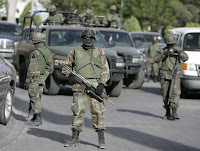 The threat that drug-related violence in Mexico poses to the United States is an important concern, but the implications of Mexico’s war on the cartels are certainly greater south of the border. Indeed, the security situation is a dire concern for the Calderon administration.
The threat that drug-related violence in Mexico poses to the United States is an important concern, but the implications of Mexico’s war on the cartels are certainly greater south of the border. Indeed, the security situation is a dire concern for the Calderon administration. The government is considering the implications of increasing casualties, not only of security forces but also of civilians. The army and federal police have shown themselves to be capable of inflicting damaging blows on the various cartels, but they have been much less successful at curbing the growing violence.
One reason for this lack of effectiveness involves the increasing responsibilities of the Mexican armed forces, perhaps the most versatile tool Calderon has relied on in the cartel war.
In addition to their traditional roles in maritime drug interdiction, marijuana and poppy crop eradication and technical intelligence operations, the armed forces have now been deployed on the ground in nearly every state in the country (with concentrations on the periphery).
One key mission for the military has been general public safety operations. In January, when drug gang violence erupted in the border city of Ciudad Juarez, Chihuahua state, some 3,000 troops were deployed to investigate cartel members and help curb the violence.
Juarez is an interesting case study of what happens when too few troops are deployed to such a large metropolitan area. In previous deployments to cities such as Reynosa, sufficient troops were available to secure the roads and disarm the local police and investigate them for links to organized crime. Such military deployments nearly always resulted in an immediate decrease in violence. In Juarez, however, the number of troops deployed was too few to disarm local law enforcement personnel.
Consequently, the police remained on duty while they were investigated by the same military personnel with whom they were being asked to cooperate on counternarcotics operations. The result was heightened tensions, poor cooperation and even a few firefights between the frustrated military and the disgruntled police.
Because the military is far more effective and less corrupt than federal and local police, it was inevitable that its role in the counternarcotics mission would evolve and expand. The result has been a classic case of mission creep. As more and more duties were assigned to the armed forces, the troops were stretched too thin to be effective.
Estimates of the current number of deployed soldiers are notoriously hard to come by, but 35,000 appears to be the maximum number that Calderon can muster in the field at any one time. In any case, investigating local police forces and assuming law enforcement duties are not missions for which Mexico’s military was designed or trained.
To be sure, Calderon has stated that the military solution is only temporary and that the ultimate goal is to reform the federal police so that they can take the lead in pursuing the country’s drug cartels. These reforms, though, have been hampered by bureaucratic turf battles between the federal attorney general’s office and the public security secretariat.
It is unclear how long Calderon originally thought it would take to implement the reforms, but some reports suggest the administration now estimates it will be at least 2012 before the federal police are prepared to take over. Reports also suggest the Calderon administration is planning to field up to 45,000 soldiers at a time until 2012 — a significant increase in military deployments.
Of course, an unexpected drop in violence could make such an escalation unnecessary. There is currently no indication that the violence will soon taper off, but it is also premature to assume that the violence will continue to escalate in the way it has so far.
For example, the February IED incident sparked concerns that additional and larger IEDs would soon become regular parts of the cartel arsenal. However, eight months later, it remains an isolated incident. Similarly, it is not at all clear that drug trafficking organizations will continue to indiscriminately kill civilians, especially given the public backlash that occurred following the Sept. 15 attack.
Despite this caveat, the danger, of course, is that the cartels have shown themselves to be remarkably innovative and resilient when backed into a corner. Given their powerful arsenals and deep penetration of the country’s security forces, a further escalation in attacks against security forces and government officials seem all but inevitable.













0 Borderland Beat Comments:
Post a Comment
Comments are moderated, refer to policy for more information.
Envía fotos, vídeos, notas, enlaces o información
Todo 100% Anónimo;
borderlandbeat@gmail.com